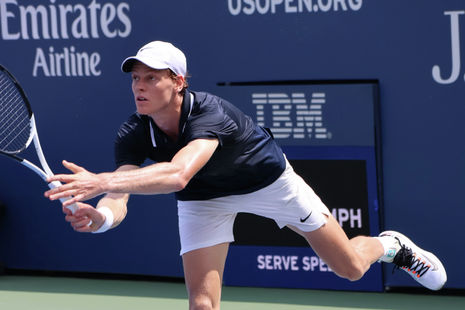Favouritism or fair treatment: what does Sinner’s scandal say about tennis’ handling of doping?
Imani Schawsmidth discusses the controversy – and potential underlying politics – behind the handling of Jannik Sinner’s recent doping scandal

It was Sunday 13th July. Nearly 9 million people tuned in to the men’s singles final on television alone. Sinner Vs Alcaraz: a close match between worthy rivals. Jannik Sinner’s eventual victory was one of grace, skill and pure focus. But looming over his success lies the undeniably scandalous Clostebol doping case, which had been haunting Sinner since March of last year.
The process following positive doping tests in tennis is fairly simple. The World Anti-Doping Agency (WADA) has a “prohibited” list of substances and methods, and any sampling which finds the presence of such substances results in an immediate provisional suspension from the sport. Sinner appealed his Clostebol suspension to the International Tennis Integrity Agency (ITIA). Subsequently, ITIA investigators – in tandem with an independent tribunal – approved of Sinner’s explanation: the anabolic steroid had been present in a cream applied to a cut on the hand of his physiotherapist, resulting in Sinner being unintentionally contaminated during a massage. The validity of his claim was bolstered by the minimal concentration of the detected substance.
“To ban, or not to ban? When is too far, and when is not far enough?”
Seemingly, the scandal was neatly put to rest, with no public knowledge of the incident and no sanction given. This changed in September 2024, when WADA appealed the Court’s “no fault or negligence” ruling, arguing Sinner ought to take a degree of responsibility for the comportment of his support team, despite the fact it acknowledged the doping was unintentional. WADA and Sinner entered a case resolution agreement, where a compromise of a 3 month ban was reached.
The details of this case will have led many to agree that it would have been excessive for the severity of Sinner’s punishment to exceed this. The ITIA is in agreement with such a view. But not all share these sympathies. Players and members of the public alike have shared frustrations with the perceived selectivity and favouritism present in the proceedings of doping cases, depending on whose reputation is at stake. There are “different rules for different players,” said former World Number 10 Lucas Pouille. Tim Henman – who is on the All England Club board that runs Wimbledon – stated in an interview with Sky Sports that the timing and duration of the ban was a “little too convenient,” implying that the brevity of the ban served to ensure that Sinner could participate in the upcoming Grand Slams. Serena Williams also commented in jest that had she been in Sinner’s position, she would have received a “20 year” ban and been stripped of her Grand Slam titles. In a bold announcement, Nick Kyrgios asserted he “did not believe in clean sport anymore”.
Sinner’s case was not the only one to raise eyebrows. It was all the more shocking that the Wimbledon women’s singles victor, Iga Światek, had similarly undergone a short investigation for a positive test of her own, resulting in a mere one month ban.
“A pattern of milder sanctions against players seems to come along with higher world ranking”
The onslaught of outrage, coupled with doping ban horror stories from lower-profile players, begs the question: to ban, or not to ban? When is too far, and when is not far enough? Players have spoken out about the paranoia and sleepless nights at the mercy of the ITIA and WADA’s doping checks. Novak Djokovic commented in a Guardian article that many of those he has conversed with believe the system to be “inconsistent” and “unfair”. It seems that players who are less well-known, with less of a stake in tennis – both financially and reputationally speaking – bear the brunt of harsher resolutions and slower proceedings. Britain’s Tara Moore was suspended in 2022, and was only cleared of any negligence after an 18 month investigation. Sinner reached a resolution with WADA within 5 months.
The speed and convenient leniency with which the two Wimbledon singles champions were able to return to the sport could indeed be a reflection of institutional favouritism, as so many in the tennis world have insisted. It is true that a pattern of milder sanctions against players seems to come along with higher world ranking. The impetus to protect the reputation and time of the player certainly appears to vary.
Some may dismiss these accusations, arguing that the game’s winners and losers will always have contrasting attitudes towards the fairness of its rules. However, if we keep in mind the starkness of the pattern at hand, we ought to take the voices of those who wield the rackets seriously.
 News / Cambridge academics stand out in King’s 2026 Honours List2 January 2026
News / Cambridge academics stand out in King’s 2026 Honours List2 January 2026 Interviews / You don’t need to peak at Cambridge, says Robin Harding31 December 2025
Interviews / You don’t need to peak at Cambridge, says Robin Harding31 December 2025 Comment / What happened to men at Cambridge?31 December 2025
Comment / What happened to men at Cambridge?31 December 2025 News / AstraZeneca sues for £32 million over faulty construction at Cambridge Campus31 December 2025
News / AstraZeneca sues for £32 million over faulty construction at Cambridge Campus31 December 2025 Features / “It’s a momentary expression of rage”: reforming democracy from Cambridge4 January 2026
Features / “It’s a momentary expression of rage”: reforming democracy from Cambridge4 January 2026










